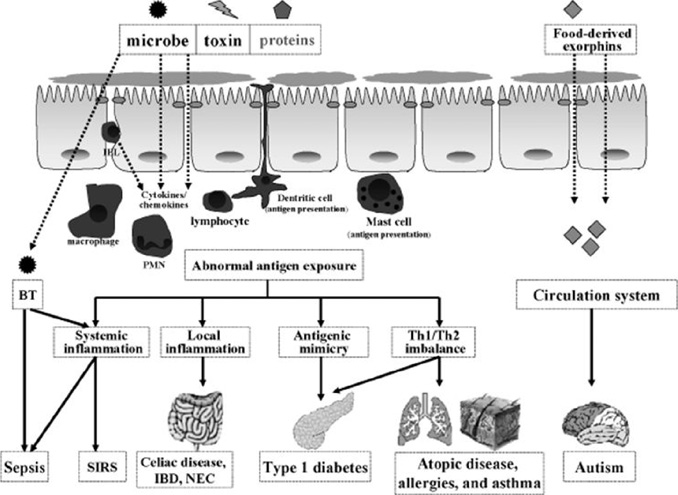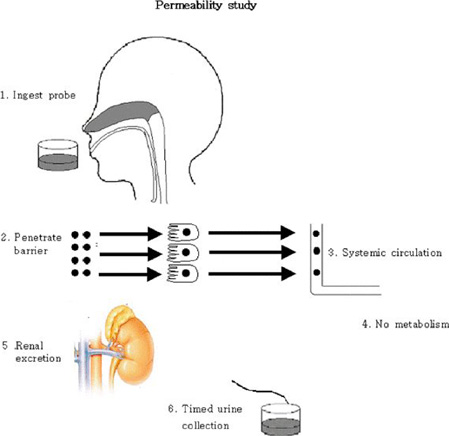Hanyang Med Rev.
2010 May;30(2):109-114. 10.7599/hmr.2010.30.2.109.
Complement and Integrative Approach in Gut Health and Immunologic Disease
- Affiliations
-
- 1Division of Gastroenterology, Department of Internal Medicine, Kangbuk Samsung Hospital, Sungkyunkwan University School of Medicine, Seoul, Korea. wookyu.jeon@samsung.com
- KMID: 2284498
- DOI: http://doi.org/10.7599/hmr.2010.30.2.109
Abstract
- The intestine is an organ involved with absorbing, processing, and transporting food into the body. However, if one were to assess the immunological portion of the intestine and compare it with better-known immunologically functioning organs such as the spleen, the intestine would be found to be the largest such organ and the extent of its immunologic function would be found to be equally proportionate. The mucosal surface of the intestine has the ability to respond to effector cells capable of protecting the host from potentially harmful organisms or local antigens. When there is increased intestinal permeability (Leaky gut syndrome), pathogenic bacteria and its products, toxins, antigens, chemicals and incompletely digested food penetrate the intestinal epithelium and are transported throughout the body. They activate the immune system and effect the pathophysiology of acute and chronic inflammatory disease and autoimmune disease. Therefore, by a better understanding of the importance of gut barrier function and the pathophysiology of gut related immunologic disease, we can make helpful suggestions for achieving optimal intestinal health.
MeSH Terms
Figure
Reference
-
1. Bourlioux P, Koletzko B, Guarner F, Braesco V. The Intestine and its microflora are partners for the protection of the host: report on the Danone Symposium "The Intelligent Intestine," held in Paris, June 14, 2002. Am J Clin Nutr. 2003. 78:675–683.
Article2. DeMeo MT, Mutlu EA, Keshavarzian A, Tobin MC. Intestinal permeation and gastrointestinal disease. J Clin Gastroenterol. 2002. 34:385–396.
Article3. Hollander D. Intestinal Permeability, Leaky Gut and Intestinal Disorders. Curr Gastroenterol Rep. 1999. 1:410–416.
Article4. Dordoni F, Zifferero M. Permeability of intestinal membrane to sulfate ion studied with radiosulfur-labeled sodium sulfate. Arch Ital Sci Farmacol. 1954. 4:287–289.5. Farhadi A, Banan A, Fields J, Keshavarzian A. Intestinal barrier: an interface between health and disease. J Gastroenterol Hepatol. 2003. 18:479–497.
Article6. Siverman MH, Ostro MJ. Bacterial endotoxin in human disease.7. Liu Z, Li N, Neu J. Tight junction, leaky intestines, and pediatric disease. Acta Paediatr. 2005. 94:386–393.8. Bjarnason I, Macpherson A, Hollander D. Intestinal permeability: an overview. Gastroenterology. 1995. 108:1566–1581.
Article9. Lipski E. Leaky gut syndrome. 1998. L.A.: Keats Publishing.10. Jeon WK. Novel nutritiontherapy: Gut integrity repair therapy with colostrums. J Korean Soc Parenter Enteral Nutr. 2004. supplement.11. Korean society of complement and intergrative medicine. Text book of complement and intergrative medicine. 2004. 1st ed. Seoul, Korea: Ehan publishing;117–129.12. Kim JW, Jeon WK. Protective effects of bovine colostrum on non-steroidal anti-inflammatory drug induced intestinal damage in rats. Asia Pac J Clin Nutr. 2005. 14:103–107.13. Kim JW, Jeon WK. Combined effects of bovine colostrum and glutamine in diclofenac-induced bacterial translocation in rat. Clin Nutr. 2005. 24:785–793.
Article
- Full Text Links
- Actions
-
Cited
- CITED
-
- Close
- Share
- Similar articles
-
- Nutritional Approach for Integrative Medicine
- What does integrative medicine mean to the physician and the ministry of health and welfare?
- The Roll of Complementary and Alternative Medicine in Integrative Medicine
- What Is Integrative Medicine?
- A Case of Meningococcal Sepsis and Meningitis with Complement 7 Deficiency in a Military Trainee




